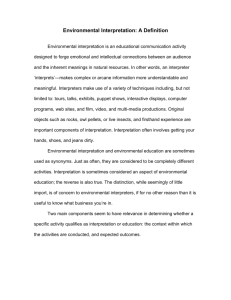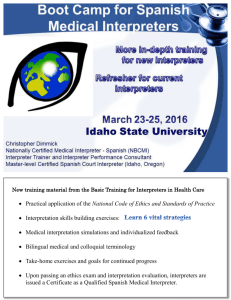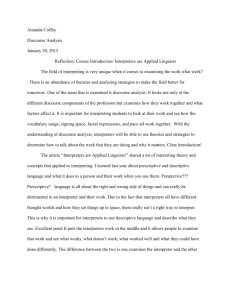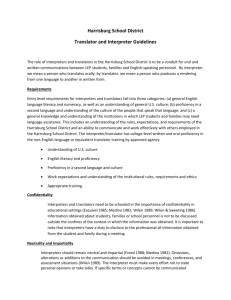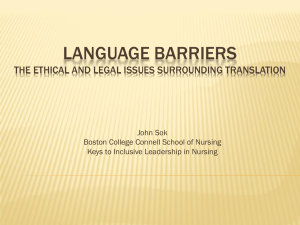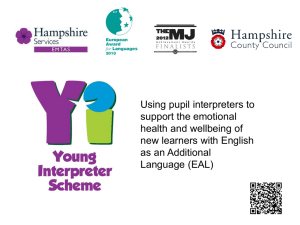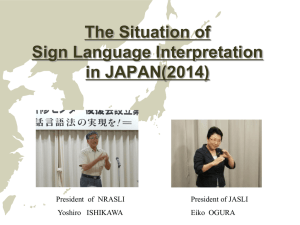SCIENTIFIC RESEARCH VS
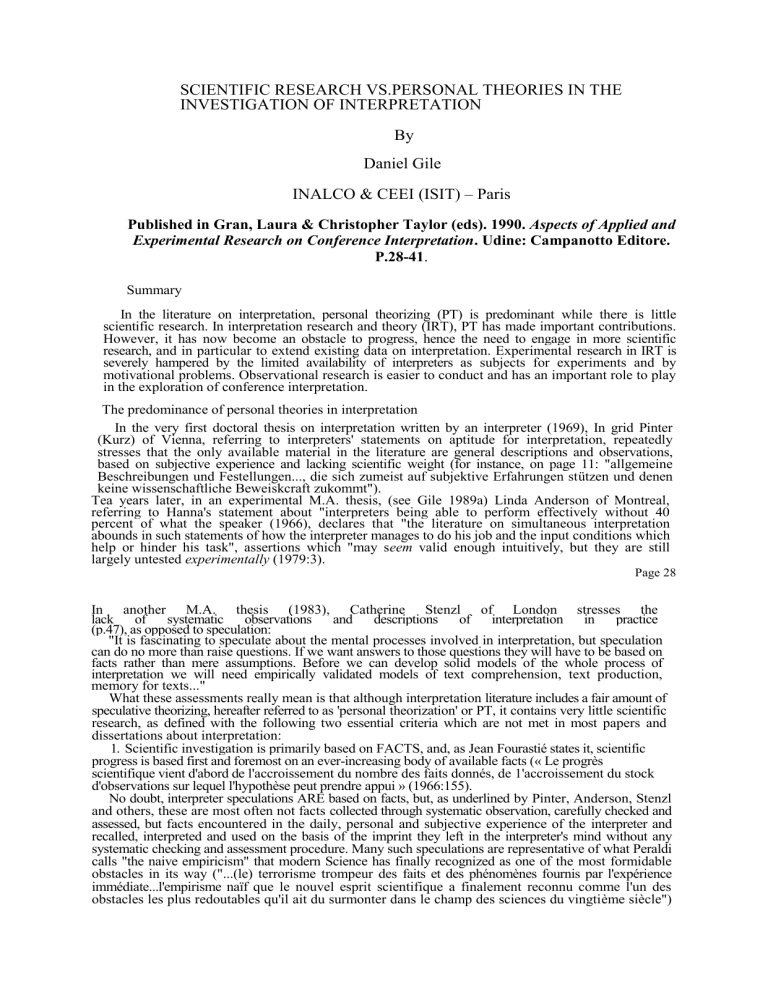
SCIENTIFIC RESEARCH VS.PERSONAL THEORIES IN THE
INVESTIGATION OF INTERPRETATION
By
Daniel Gile
INALCO & CEEI (ISIT) – Paris
Published in Gran, Laura & Christopher Taylor (eds). 1990. Aspects of Applied and
Experimental Research on Conference Interpretation. Udine: Campanotto Editore.
P.28-41
.
Summary
In the literature on interpretation, personal theorizing (PT) is predominant while there is little scientific research. In interpretation research and theory (IRT), PT has made important contributions.
However, it has now become an obstacle to progress, hence the need to engage in more scientific research, and in particular to extend existing data on interpretation. Experimental research in IRT is severely hampered by the limited availability of interpreters as subjects for experiments and by motivational problems. Observational research is easier to conduct and has an important role to play in the exploration of conference interpretation.
The predominance of personal theories in interpretation
In the very first doctoral thesis on interpretation written by an interpreter (1969), In grid Pinter
(Kurz) of Vienna, referring to interpreters' statements on aptitude for interpretation, repeatedly stresses that the only available material in the literature are general descriptions and observations, based on subjective experience and lacking scientific weight (for instance, on page 11: "allgemeine
Beschreibungen und Festellungen..., die sich zumeist auf subjektive Erfahrungen stützen und denen keine wissenschaftliche Beweiskcraft zukommt").
Tea years later, in an experimental M.A. thesis, (see Gile 1989a) Linda Anderson of Montreal, referring to Hanna's statement about "interpreters being able to perform effectively without 40 percent of what the speaker (1966), declares that "the literature on simultaneous interpretation abounds in such statements of how the interpreter manages to do his job and the input conditions which help or hinder his task", assertions which "may s eem valid enough intuitively, but they are still largely untested experimentally (1979:3).
Page 28
In another M.A. thesis (1983), Catherine Stenzl of London stresses the lack of systematic observations and descriptions of interpretation in practice
(p.47), as opposed to speculation:
"It is fascinating to speculate about the mental processes involved in interpretation, but speculation can do no more than raise questions. If we want answers to those questions they will have to be based on facts rather than mere assumptions. Before we can develop solid models of the whole process of interpretation we will need empirically validated models of text comprehension, text production, memory for texts..."
What these assessments really mean is that although interpretation literature includes a fair amount of speculative theorizing, hereafter referred to as 'personal theorization' or PT, it contains very little scientific research, as defined with the following two essential criteria which are not met in most papers and dissertations about interpretation:
1. Scientific investigation is primarily based on FACTS, and, as Jean Fourastié states it, scientific progress is based first and foremost on an ever-increasing body of available facts (« Le progrès scientifique vient d'abord de l'accroissement du nombre des faits donnés, de 1'accroissement du stock d'observations sur lequel l'hypothèse peut prendre appui » (1966:155).
No doubt, interpreter speculations ARE based on facts, but, as underlined by Pinter, Anderson, Stenzl and others, these are most often not facts collected through systematic observation, carefully checked and assessed, but facts encountered in the daily, personal and subjective experience of the interpreter and recalled, interpreted and used on the basis of the imprint they left in the interpreter's mind without any systematic checking and assessment procedure. Many such speculations are representative of what Peraldi calls "the naive empiricism" that modern Science has finally recognized as one of the most formidable obstacles in its way ("...(le) terrorisme trompeur des faits et des phénomènes fournis par l'expérience immédiate...l'empirisme naïf que le nouvel esprit scientifique a finalement reconnu comme l'un des obstacles les plus redoutables qu'il ait du surmonter dans le champ des sciences du vingtième siècle")
(1982:10).
2. Scientific research requires the methods and reasoning process to be made explicit for the benefit of the reader, who can thus assess their accuracy and validity, and replicate experiments to check the results.
For some scientists, in particular the psychologist Maurice Reuchlin, THE criterion by which to judge the scientific value of an observation method is necessarily the controllability of its results (1969:35).
In most of the literature on interpretation, the methods and data on which ideas are based are not made explicit. For example, Catherine Stenzl points out that "Lederer (1981) does not reproduce the entire interpretations of her source texts and gives little information that is based on the corpus as a whole. It is therefore impossible to assess the representativeness of me passages she discusses" (1983:47).
Page 29
The resulting texts are by no means devoid of value, as is explained elsewhere in this paper, but they do pose some problems, as is shown by the following examples, taken from Danica Seleskovitch’s
Langage, langues et mémoire (1975), the published version of her doctoral dissertation:
On page 1, the author asserts that interpreters (“all” is implicit in the sentence) refuse to do a sentence by sentence consecutive.
On page 2, she refers to statements made by “all” interpreters regarding their profession, “the same” everywhere and whatever the languages involved;
On page 5, she declares that differences in the way languages describe reality have no impact on the difficulty of interpretation.
On page 42, she states that “10, 20 or 100 new technical terms” are enough to interpret in any specialized field.
On page 116, she formulates as a fact the idea that whatever the speed of delivery, the density of speeches is the same for all speakers.
These assertions, which are not statements of obvious facts, are made without any explanation as to the bibliographical sources, observed facts or experiments they are based on, and therefore do not permit any control of the sources or the procedures that led the author to their formulation.
In the eyes of members of the scientific community, this may, and indeed does (we heard personally comments to that effect) bring some discredit upon the author as a scientist, and by extension on interpretation research as a whole.
Furthermore, in the interpreting community, many do not agree with Seleskovitch’s above statements.
In fact, we have personally seen a number of times interpreting doing a consecutive on a sentence by sentence basis, and as evidenced by personal glossaries prepared before and during conferences by many interpreters we have worked with, such glossaries often contain hundreds of terms (see section IV in Gile 1989b).
On the question of the relative difficulty of interpretation depending on the languages involved, there is a fair amount of literature in total disagreement with Seleskovitch’s opinion (see for instance
Ilg 1978, Wilss 1978, Le Ny 1978, Fukuii and Asano 1961, Kunihiro, Nishiyama and Kanayama
1969), and as regards the relation between delivery speed and density, we have personally put the question to interpreters and have found that many disagree with Seleskovitch.
Such disagreements are not necessarily expressed in writing, as only a few dozen interpreters actually write papers on theoretical research matters. However, formulated as they are in such a categorical way, without any explanations as to the way they were derived and without any qualifications as to their scope, the above statements tend to generate some cynical, and sometimes hostile feelings towards interpretation research, as we experience in our own conversations with colleagues.
Page 30
The lack of consideration from fellow interpreters is unpleasant; the lack of consideration from fellow researchers in the scientific community also makes it more difficult to establish links with them for multidisciplinary cooperation in research.
The main reasons for the speculative dominance in interpretation literature are rather easy to guess:
- Most interpreters who engage in interpretation investigation are not scientists by training (those who do have such training have a different approach) and possibly do not have the know-how or the inclination to do scientific work. As to non-interpreters, except for those working in interpretation schools, who indeed do scientific work (Sylvie Lambert of Ottawa and Nancy Schweda-Nicholson of the University of Delaware, for instance), most do not have or maintain contacts with the interpreting research community, possibly to a large extent because of the speculative nature of the work they hear about in whatever conferences interpreters give papers. The interpretation investigator’s community may be in the process of breaking away from this situation with the work conducted at the Trieste school over the past few years (see Gran and Dodds 1989 as well as the first two issues of The
Interpreters’ Newsletter
).
- Scientific research requires considerable time and effort, and practicing interpreters have little time for this type of work. They do accept the efforts required to obtain a university degree, but generally stop there. When asked to produce papers, they understandably tend to choose the easy way, namely speculative reflection.
- Last but not least, there is a certain “defensiveness” among interpreters as regards scientific investigation.
Stenzl (1983:42) writes the following: “We are quite pleased when psychologists confirm that ours is a complex job which requires a number of highly developed skills, but we are perhaps less inclined to documents the limits of our skills and to face the occasions when we did not properly understand a speaker or were unable to adequately render a message even if we had understood it.”
Miriam Shlesinger of Tel-Aviv is more explicit: “…those describing interpretation from the practitioner’s standpoint are sometimes prone to a certain lack of detachment which surfaces in these writings in the form of a sense of awe at an impossible job incredibly done” (1989:8).
This lack of detachment and the quest for personal or collective prestige can lead to more than mere
“defensiveness” as regards scientific investigation of interpretation. Recently, one influential practitioner and member of the Interpretation investigators’ community actually tried to prevent a doctoral dissertation on interpretation by a fellow practitioner from being defended on the ground that members of the jury were not interpreters (one WAS a professional interpreter, and the others were linguists specializing in oral communication, lexicology and translation), and therefore “had no
Page 31
_______________________________________________________________________________
Competence whatsoever” and “would be utterly ridiculous” if they ventured to judge the dissertation.
One should stress that this attitude is not pandemic among interpretation investigators. However, until recently, it was the small group of interpreters which was most active in terms of publications that also was most prone to display such defensiveness, and even aggressiveness towards scientific research. It follows that many readers of publications on interpretation, including interpreters, think of this group as representative of all interpreting research and theory (IRT). In this respect, the openminded activity of the Trieste school, as shown in particular at the 1986 Symposium during which some well-established ideas were challenged (Gran and Dodds 1989), will hopefully help to dispel this erroneous impression by adding some weight to the individual action of researchers such as Ingrid
Kurz, Linda Anderson, Barbara Moser, Jennifer Mackintosh, Catherine Stenzl, Sylvie Lambert, Nancy
Schweda-Nicholson and others.
Is PT inferior to scientific research?
Setting aside the behavioural aspect of the above phenomena, which is not an intrinsic part of PT, the most fundamental question that can be put regarding personal theorizing is probably whether its contribution to the advancement of knowledge about interpretation is significant, ‘unscientific’ as it may be, or whether science is a prerequisite to any significant progress in its investigation.
PT is based on personal experience and intuition, and does not have to submit to strict principles and rules as is the case with scientific investigation. It therefore may lead to erroneous conclusions without there being a way to check where and why things went wrong, as opposed to science, which has built-in controls. Does this mean that conclusions arrived at by PT are less ‘true’ than those
reached by scientific research?
The answer to this question is by no means clear-cut. Scientific research often arrives at the same conclusions as speculation, and the time required to reach them is generally much longer because of the controls (strict experimental procedures, replication, caution in inferencing and conclusiondrawing). Furthermore, the controls do not guarantee the correctness of results: scientific research does away with some traps that subjective uncontrolled perception tends to be associated with, but as is shown in a later part of this paper and in the second paper given this morning(Gile 1990a), it is not immune from other types of biases and errors.
The investigation of interpretation first became necessary for training purposes. Errors did not have serious consequences as they would have in medicine or engineering applications, for example, but speed was of the essence, as training was urgent. Personal theorizing by Herbert (1952) and others led to a philosophy of interpreting based on comprehension and
Page 32
Reformulation rather than transcoding, a philosophy which is still predominant. As to scientific research conducted in the field of interpreter training (see for instance Moser 1978), it does not seem to have had any significant effect on training methods and results except in courses given by the researchers themselves, and sometimes in the schools where they teach, but on the whole, interpretation instructors prefer to keep their personal, most often traditional methods, and take no heed of research.
Another aspect of the question which should be borne in mind is the motivational force of PT in interpretation investigation among interpreters. In the sixties, most of the work was scientific (Oléron and Nanpoin 1965, Treisman 1965, Lawson 1967, Barik 1969, Gerver 1969, Pinter 1969) and did not seem to inspire but a dozen authors or so. Since the mid-seventies, speculative work carried out by
Seleskovitch and others has generated interest in many interpreters, as evidenced by the abundance of articles that appeared in professional journals and by a number of theses and dissertations in the late seventies and early eighties. This should not lead to the hasty conclusion that as a rule, personal theorizing has an intrinsically stronger motivational effect than scientific research. It seems that the driving force behind this upsurge of interest in IRT was the very forceful personality of one individual.
It is difficult to guess what the results would have been had that individual been more inclined towards science and less towards speculation, but the fact is that historically speaking, it is through PT that IRT really got off to a start and, in particular, that the world’s first translation and interpretation doctoral studies program was established (at the Université de la Sorbonne Nouvelle – Paris III), which without doubt is a very important development.
We do not consider that the fact that IRT was launched and dominated in the beginning by PT was an unfortunate one. PT did lead to a number of ideas (or “theories” which were used as a foundation for interpreter training policies. However thin these foundations may seem to be, the policies have led to practical methods in interpreter training which have generated what is generally considered to be a reliable system. For instance, Seleskovitch’s idea (1975) that a “deverbalization” stage occurs somewhere between the perception of the original speech and the reformulation of its “message” into the target language by the interpreter (a stage at which only the “meaning” remains in the interpreter’s mind without any trace of its linguistic vehicle) is far from proven; however, it does lead teachers to instruct students to move away from the linguistic structure of the source language speech and reformulate the ideas it contains in their own words, thus forcing them to analyze the speech and making them adapt their own speech to their listeners. This is good intellectual exercise and generates source language speeches which are easier to comprehend than the ones based on transcoding. Had the interpreting community waited for research to establish scientifically that there is indeed a
“deverbalization” stage before defining training policies and methods, chances are little headway would have been made to date.
Page 33
Neither do we think that science is intrinsically better than personal theorization during the initial stage of exploration in a new field. We believe problems lie further down the road.
To be more specific, after the initial results of PT, which, as explained above, we consider both interesting and useful, things seem to have come a stop: colleagues who engaged only in PT failed to produce new ideas or new facts to support their opinions in spite of the publication of papers challenging such opinions, in particular regarding such issues as the language specificity of interpretation, the importance of consecutive in interpretation training (see for example Francis 1989), or the desirability of working from one’s A language into one’s B language (see Denissenko 1989).
The fact that such colleagues strongly adhere to their opinions is not objectionable per se; in fact, it would be positive if they were adding facts to defend their case and thus contributing to the knowledge of interpretation. However they do not, and over the past fifteen years or so, very little has been gained in the knowledge of interpretation from PT while assertions and counter-assertions have been building up.
The potential contribution of scientific research to the investigation of interpretation
It is in the context of this deadlock that the advantages of scientific research became most salient because of two of its most fundamental characteristics, namely the fact that it progresses on the basis of systematic data collection, be it observational of experimentally derived, and the fact that, as mentioned in the beginning of this paper, it makes explicit the data and methods, thus making it possible for researchers and practitioners to assess their representativeness, correctness and/or accuracy.
In particular, the extension of each investigator’s data base thanks to the pool of information gathered by other colleagues with a different experience, working with different languages, with different clients, in different political, economic and social environments, may strengthen or weaken existing opinions and generate new ideas.
It should be stressed nevertheless that scientific research has not only limitations, but also ‘in-built’ weaknesses.
Advantages and limitations of experimental research
Before discussing these, it may be useful to distinguish between two fundamental types of scientific investigation, namely experimental research and observational research. Observational research (OR) is based on systematic collection of data as observed in the field without manipulating situations for the purpose of obtaining this data. Experimental Research (ER)
Page 34 consists in creating or changing situations for the specific purpose of generating data as required.
Over the years, experimental research has become very important in the eyes of researchers in many disciplines, inter alia in the behavioural sciences, and in psychology, linguistics and psycholinguistics in particular, to the extent that many equate ‘science’ with experimental research and deny ‘scientific value’ to any endeavours which are not experimental. It is striking to find that even
Pinter (1969) and Anderson (1979), both interpreters, both certainly familiar with sampling and other methodological problems in IRT experimenting, do not refer at all to observational research and only mention experimenting as a means of validating interpretation hypotheses scientifically.
One of the main advantages of experimentation over observation lies in the fact that the former can filter out some ‘noise’ by controlling those parameters which may otherwise interfere with the interaction between the variables under study and thus prevent their accurate observation. The main disadvantage of experimentation lies in the fact that it requires the creation of an artificial environment that many not only filter out outside influences, but also cut out part of the phenomenon under study or change it. For instance, by using especially composed texts with particular linguistic features in interpreting experiments in order to eliminate effects due to differing characteristics associated with authentic speeches, the experimenter may be changing pauses, intonations and rhythmic elements which play a significant role in interpreting performance and thus may be introducing noise of a different kind. This limitation is particularly significant in the behavioural sciences because of the
large number and complex interactions of variables relevant to many of the phenomena being studied.
ER problems in interpretation research
The problem is salient in interpretation research. To illustrate this point, suffice it to note that interpreters have asserted that the following parameters influence their performance: source language, speed of delivery, style, degree of specialization of the speech, speaker pronunciation, environmental noise, temperature in the booth, visibility of the speaker and the conference room, prior knowledge of the subject, general mental condition and state of health of the interpreter, including his physical condition, his experience, talent, honesty, personal relations between team members, the number of delegates listening to the interpretation, organizers’ and the delegates’ attitude towards the interpreters.
It is obviously difficult to control all these variables and their interactions, which leads some practitioners to reject experiments outright.
Another methodologically serious difficulty is the limited availability of interpreters as subjects for experiments. One problem is objective: the total
Page 35
________________________________________________________________________________ number of conference interpreters worldwide is comparatively small, a few thousand spread out over the 5 continents, so that it is difficult to find a sufficient number of subjects for experiments while controlling all relevant variables in any single geographical location (in Paris, Tokyo, Brussels and
Geneva, the largest interpretation centers, there are not more than a few hundred interpreters, who cover a wide range of languages, years of experience etc.). A further problem lies in the fact that interpreters feel vulnerable and many are reluctant to expose themselves and their weaknesses to experimenter (this question is discussed in more detail in Gile 1989b, chapters 17 & 18).
The actual contribution of ER in IRT
Looking back at the contribution of experimental research in interpretation research and theory so far, as mentioned by Pinter, Anderson, Stenzl, and most recently, by Dillinger 1989 (chapters 1 & 2 ), very little experimenting has been done to date.
Most of the ER conducted by non-interpreters suffers from methodological weaknesses which shed serious doubts on the validity of its results. The most significant shortcomings are the following:
Small non-random samples (10 to 12 interpreters in Gerver 1969 and 1974, 8 subjects in
Kopczynski 1980, 6 subjects in Goldman-Eisler 1972 and Barik 1971, 4 subjects in Chernov
1969), which considerably reduces the validity of statistical tests performed on this basis
(Hansen, Horvitz & Madow 1953:73, Snedecor & Cochran 1967:509).
In much of the research, subjects were not professional interpreters but interpreting students or bilinguals with no training at all in interpretation (Treisman 1965, Goldman-Eisler 1967,
Lawson 1967, Chernov 1969, Barik 1971, Kopczsynski 1980).
Experimental conditions are different from authentic conditions in ways which interpreters believe to be significant: speeches of a type that is never interpreted in practice (the UNESCO courier in Gerver 1974), interpreters working from and into languages in a combination unusual for them (Barik 1971, 1973, 1975, Oléron & Nanpon 1965) or ‘interpreting’ random strings of words (Treisman 1965).
It is worthy of note that interpreters’ experiments (for instance Pinter 1969, Anderson 1979,
Mackintosh 1983) are closer to field reality, but their very small number as well as sampling, statistics and other methodological problems discussed in Gile 1990a limit the relative weight of their contribution to IRT so far.
Page 36
________________________________________________________________________________
Observational research
In the basic pattern of scientific research accepted worldwide, observation precedes experimenting.
Though there seem to be no precise definition or rule regarding the amount of observation that should be performed before experimenting starts, as noted by Stenzl (1989:24), in the “literature on interpretation it is striking that practically no systematic descriptive studies have been published, so that we have no data based on observation of what interpreters do”. Many of the failing of experimental research conducted up to now may be at least partly due to the lack of such observational data, with investigators not knowing enough about actual practice to set up appropriate experimental conditions.
We believe, as does Stenzl, that many questions on interpretation “can’t be answered without a broad, systematically collected basis of observational data” (Stenzl 1983:52), and that “the collection of such a data base therefore seems an urgent and important task” (Stenzl 1983:52).
In view of the limitations of ER and IRT as explained above, the fact that field observation does not control variables and parameters no longer seems to be so much of a handicap. Though observational research does not reduce variability, it provides authentic data, while experimental data may be totally unrepresentative of processes involved in interpretation. It follows that the results of ER may be challenged and entirely discarded, as opposed to OR data. Furthermore, a major advantage of ER over
OR, namely the fact that a sample of subjects can perform the same task under identical conditions and thus lead to generalizations for the entire population through the use of statistics, is weakened in IRT because of the use of small, non-random samples with a bias the nature, direction and magnitude of which are unknown. In this respect, the comparison of data from a collection of case studies may lead to generalizations which are just as reliable, provided that the researcher carefully studies field conditions, that he decides relevant parameters are similar and allow the comparison, and provided he gives a full and precise description of field conditions so that other investigators can also assess the comparability of the data.
Furthermore, in the field of IRT, observation has what can be considered a major advantage over experimenting: it requires self-discipline and an objective mind, but no specialized skills in research methods, and statistics in particular. It can therefore be conducted with reasonable efficiency by interpreters who have had little scientific training.
Up to now, there has been comparatively little observational research in IRT. Most of the work done was questionnaire-based (Thiéry 1975, Gerver 1976, Lambert & Lambert 1985, Rojas 1987). As to direct field observation, noteworthy are two very recent theses from Israel, Morris 1989 and
Shlesinger 1989, which show, as do Gile 1987 and other paper on
Page 37
______________________________________________________________________________
Interpretation training, how field data can be used in the quest for answers to specific questions.
As explained in Gile 1988, non-interpreters seem to have lost interest inert over the past 10 years or so, and if headway is to be made, at the present point in time, impetus should come from interpreters.
The fact that most have little or no scientific training is a further argument in favour of giving priority to observational research in a general strategy for the advancement of IRT.
Conclusion
After more than 20 years of investigation, IRT is still under-developed. This seems to be inter alia the result of a lack of observational data which could have been used in experimental research and theorization, rather than the reflection of a ‘lesser’ absolute value of theorization as opposed to experimental and observational research. Nevertheless, though personal theorizing was undoubtedly useful in the beginning stages of investigation into interpretation, it seems to have lost its momentum and has contributed very little over the past ten years or so.
We therefore believe that at the present point in time, priority should be given to research so that more hard data is made available for a serious discussion of basis issues. In this respect, the Trieste school again sets a good example, with a relative wealth of experimental studies published in the
Interpreters’ Newsletter
. We hope this example will be followed by others.
References
Anderson, Linda. 1979. Simultaneous Interpretation: Contextual and Translation Aspects . MA thesis, Concordia
University, Canada.
Barik, Henri. 1969. A Study in Simultaneous Interpretation . PhD Dissertation, University of North Carolina.
Barik, Henri. 1971. A Description of Various Types of Omissions, Additions and Errors Encountered in
Simultaneous Interpretation. Meta 15:1. 199-21.
Barik, Henri. 1973. Simultaneous Interpretation: Temporal and Quantitative Data. Language and Speech 16.
237-270.
Barik, Henri. 1975. Simultaneous Interpretation: Qualitative and Linguistic Data. Language and Speech 18. 272-
297.
Chernov, Ghelly. 1969. Linguistic Problems in the Compression of Speech in Simultaneous Interpretation.
Tetradi Perevodchika 6. 52-65.
Page 38
_
_____________________________________________________________________________
Denissenko, Jurij. 1989. Communicative and Interpretative Linguistics. In Gran & Dodds (eds). 155-158
Dillinger, Michael. 1989. Component Processes of Simultaneous Interpreting . Doctoral dissertation, McGill
University, Montreal.
Fourastié, Jean. 1966. Les conditions de l’esprit scientifique . Paris : Gallimard.
Francis, Michael. 1989. The Teaching of Conference Interpreting : a Pragmatist’s View. In Gran & Dodds (eds).
249-252.
FUKUII, Haruhiro & Tasuke ASANO. 1961. eigotsuuyaku no jissai . Tokyo: Kenkyusha.
Gerver, David. 1969. The Effects of Source Language Presentation Rates on the Performance of Simultaneous
Conference Interpreters. In Foulke, E (ed). Proceedings of the Second Louisville Conference on Rate and/or
Frequency Controlled Speech , University of Louisville. 162-184.
Gerver, David a H. Wallace Sinaiko (eds). 1978. Language Interpretation and Communication . New York and
London: Plenum Press
Gile, Daniel. 1987. Les exercices d’interprétation et la dégradation du français : une étude de cas. Meta 31:4.
420-428.
Gile, Daniel. 1988. An Overview of Conference Interpretation Research and Theory. In Deanna Hammond (ed.),
Languages at Crossroads, Proceedings of the 29th Annual Conference of the American Translators' Association ,
October 12-16 (Seattle), Medford, NJ, Learned Information, pp.363-372.
Gile, Daniel. 1989a. . Simultaneous Interpretation: Contextual and Translation aspects - Un travail expérimental de Linda Anderson (review),
The Interpreters’ Newsletter
N.2: 70-72.
Gile, Daniel. 1989b. La communication linguistique en réunion multilingue: les difficultés de la transmission informationnelle en interprétation simultanée , doctoral dissertation, Université de la Sorbonne Nouvelle, Paris,
484 pages
Gile, Daniel. 1990a. Scientific Research vs. Personal Theories in the Investigation of Interpretation. Paper given at the Scuola Superiore di Lingue Moderne per Interpreti e Traduttori, Università degli Studi di Trieste, March
19.
Gile, Daniel. 1990b. Interpretation Research Projects for Interpreters. Paper given at the Scuola Superiore di
Lingue Moderne per Interpreti e Traduttori, Università degli Studi di Trieste, March 19.
Goldman-Eisler, Frieda. 1972. Segmentation of Input in Simultaneous Interpretation. Psycholinguistic research n°1. 127-140.
Page 39
_______________________________________________________________________________
Gran, Laura & John Dodds (eds). 1989. The Theoretical and Practical Aspects of Teaching Conference
Interpretation . Udine: Campanotto Editore.
Hanna, Blake T. 1966. Oral comprehension. Meta 11:2.
Hanse, M. W. Horwitz & W. Madow. 1953. Sample Survey Methods and Theory. New York, London, Sydney:
John Wiley & Sons.
Herbert, Jean. 1952. Le manuel de l’interprète . Genève : Georg.
Ilg, Gérard. 1978. L’apprentissage de l’interprétation simultanée de l’allemand vers le français. Parallèles n°1,
Cahiers de l’E.T.I., Genève.
Kopczynski, Andzej. 1980. Conference Interpreting. Some Linguistic and Communicative Problems . Nauk,
Poznan : Wydawn.
KUNIHIRO, Masao, Sen NISHIYAMA & Nobuo KANAYAMA. 1969. Tsuuyaku eigokaiwa kara doujitsuuyaku made . Tokyo : Nihonshuppankyokai.
Lambert, Sylvie-Michèle & Wallace Earl Lambert. 1985. Physiology : a questionnaire. Meta 30 :1.
Lawson, Everdina. 1967. Attention and Simultaneous Translation. Language and Speech 10 :1.
Lederer, Marianne. 1981. La traduction simultanée. Fondements théoriques . Paris : Minard.
Le Ny, Jean-François. 1978. Psychosemantics and Simultaneous Interpretation. In Gerver & Sinaiko (eds). 289-
298.
Mackintosh, Jennifer. 1983. Relay Interpretation: an Exploratory Study . MA thesis, University of London.
Morris, Ruth. 1989. The impact of interpretation on legal proceedings . MA thesis, Communication Institute,
Hebrew University of Jerusalem.
Moser, Barbara. 1978. Simultaneous Interpretation: A Hypothetical Model and its Practical Application. In
Gerver & Sinaiko (eds). 353-368.
Oléron, P. et Henri Nanpon. 1964. Recherches sur la traduction simultanée. Journal de Psychologie Normale et
Pathologique 62. 73-94.
Page 40
_
________________________________________________________________________________
Peraldi, F. 1982. Psychanalyse et traduction. Meta 27 :1.
Pinter, Ingrid. 1969. Der Einfluss der Übung und Konzentration auf Simultanes Sprechen und Hören .
Unpublished doctoral dissertation, University of Vienna.
Reuchlin, Maurice. 1969. Les méthodes en psychologie . Paris : PUF.
José Rojas. 1987. A Survey on Job Satisfaction of Free-Lance (and Permanent) Conference Interpreters
Domiciled in the Geneva Area. Term paper, unpublished, Webster University, Geneva.
Shlesinger, Miriam. 1989. Simultaneous Interpretation as a Factor in Effecting Shifts in the Position of Texts on the Oral-Literate Continuum . MA thesis, Tel-Aviv University.
Seleskovitch, Danica. 1975. Langage, langues et mémoire. Paris : Minard.
Snedecor, George W. & William Cochran. 1969. Statistical Methods . 6th Edition, Ames, Iowa : the Iowa State
University.
Stenzl, Catherine. 1983. Simultaneous Interpretation – Groundwork towards a Comprehensive Model. MA thesis,
University of London.
Thiéry, Christopher. 1975. Le bilinguisme chez les interprètes de conférence professionnels . Thèse de doctorat de 3
ème
cycle, Université Paris 3.
Treisman, A. 1965. The Effects of Redundancy and Familiarity on Translation and Repeating Back a Native and
Foreign Language. British Journal of Psychology 56. 369-379
Wilss, Wolfram. 1978. Syntactic anticipation in German-English Simultaneous Interpreting. In Gerver & Sinaiko
(eds). 343-352.
Page 41
